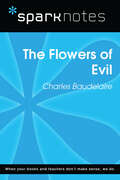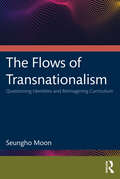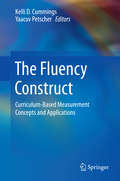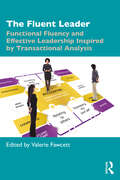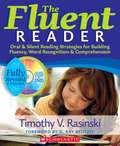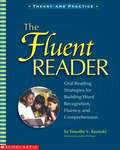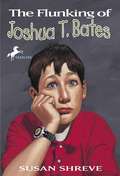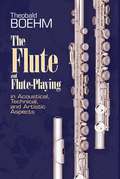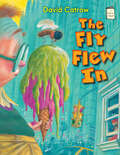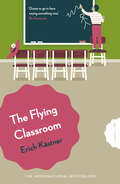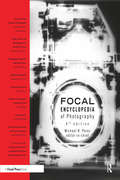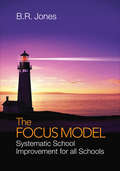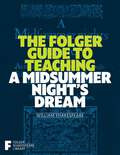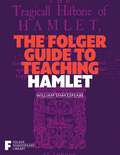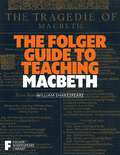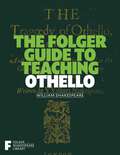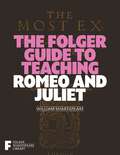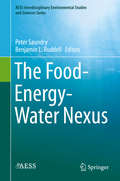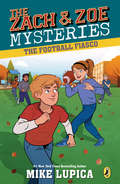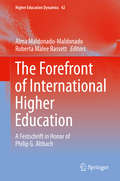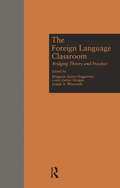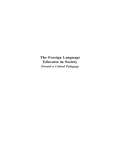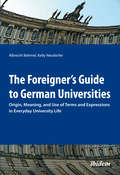- Table View
- List View
The Flowers of Evil (SparkNotes Literature Guide Series)
by SparkNotesThe Flowers of Evil (SparkNotes Literature Guide) by Charles Baudelaire Making the reading experience fun! Created by Harvard students for students everywhere, SparkNotes is a new breed of study guide: smarter, better, faster.Geared to what today's students need to know, SparkNotes provides:chapter-by-chapter analysis explanations of key themes, motifs, and symbols a review quiz and essay topics Lively and accessible, these guides are perfect for late-night studying and writing papers.
The Flows of Transnationalism: Questioning Identities And Reimagining Curriculum
by Seungho MoonThis reflexive, transcultural dialogue scholarship integrates autobiography alongside an in-depth, critical analysis of Eastern and Western philosophy. Moon revisits his cultural heritage providing rich narratives that debunk a universalized, Eurocentric approach to truth in the contemporary curriculum and social discourse. As an exploration of multiple versions of knowing and identities, The Flows of Transnationalism allows readers to extend and invent their own approaches to examining the fluidity of identities. Moon promotes diverse perspectives within curriculum studies by disrupting the self-other and cultural sameness-difference dichotomy. Amid the urgent need of developing anti-racist pedagogy, this book provides an innovative way to studying identities in a transnational context. This thought-provoking book on transculturalism, cultural identities, and curriculum is intended to benefit educators, university faculty, and interested members of the public. It is written for those who have the desire to learn and apply diverse approaches for engaging with cultural identities through lived experience and its sociopolitical interpretation.
The Fluency Construct
by Kelli D. Cummings Yaacov PetscherThis book provides a comprehensive overview of fluency as a construct and its assessment in the context of curriculum-based measurement (CBM). Comparing perspectives from language acquisition, reading, and mathematics, the book parses the vagueness and complexities surrounding fluency concepts and their resulting impact on testing, intervention, and students' educational development. Applications of this knowledge in screening and testing, ideas for creating more targeted measures, and advanced methods for studying fluency data demonstrate the overall salience of fluency within CBM. Throughout, contributors argue for greater specificity and nuance in isolating skills to be measured and improved, and for terminology that reflects those educational benchmarks. Included in the coverage: Indicators of fluent writing in beginning writers. Fluency in language acquisition, reading, and mathematics. Foundations of fluency-based assessments in behavioral and psychometric paradigms. Using response time and accuracy data to inform the measurement of fluency. Using individual growth curves to model reading fluency. Latent class analysis for reading fluency research. The Fluency Construct: Curriculum-Based Measurement Concepts and Applications is an essential resource for researchers, graduate students, and professionals in clinical child and school psychology, language and literature, applied linguistics, special education, neuropsychology, and social work.
The Fluent Leader: Functional Fluency and Effective Leadership Inspired By Transactional Analysis
by Valerie FawcettIn this insightful and comprehensive volume, leaders and managers can explore how they can use their power and choice of behavioural options more effectively to develop a positive and healthy working environment where people and the organization can succeed. Based on the Functional Fluency model as it was developed by Dr Susannah Temple, this book details the art and skill of interpersonal effectiveness, describing the behaviours that enable human beings to get along well together and to flourish and thrive. Fluent leaders make positive and flexible responses which help things turn out well, instead of repeating old automatic reactions that sometimes make things worse. By inspiring and motivating others, they manage and lead constructively, saving time, energy, and stress. Further, becoming functionally fluent will improve their problem-solving, decision-making, and communication skills, enabling them to cultivate successful relationships. Through engaging case studies and opportunities for personal reflection, The Fluent Leader addresses situations leaders face as managers, team leaders, senior executives, and change agents. The Fluent Leader guides leaders and managers, at all levels in any kind of organization, in how to use the most effective behaviours, and how to change ineffective behaviours, which are draining them or holding them back.
The Fluent Reader 2nd Ed
by Timothy V. RasinskiTim Rasinski's groundbreaking book has been updated to include coverage of the latest research on fluency, teaching strategies based on that research, new classroom vignettes, and suggestions for using a variety of texts to teach fluency such as poetry, speeches, and monologues and dialogues. You'll also find background information, assessment tools, step-by-step lessons, and teaching tips--plus video clips showing the strategies in action. For use with Grades 1-8.
The Fluent Reader: Oral Reading Strategies for Building Word Recognition, Fluency, and Comprehension
by Timothy V. RasinskiThis book will make you smile with its brilliant explanations of how to teach students to read.
The Flunking of Joshua T. Bates
by Susan ShreveJoshua is devastated to learn that he must repeat third grade. But he manages to survive the taunts of former classmates, learn something important about himself, and make it through the year with the help of a sympathetic teacher.
The Flute and Flute Playing: In Acoustical, Technical, And Artistic Aspects (classic Reprint) (Dover Books On Music: Instruments)
by Theobald BoehmThe flute (or closely related instrument) has been known since prehistoric times, but up until the middle of the nineteenth century it was still far from being a satisfactory instrument, despite the quantity of important music that had been written for it. Its tone was poor and thin, its volume was low, its keying system was inefficient, and it was very difficult to play.The man who changed all this and invented the modern flute was Theobald Boehm (1794-1881), a Bavarian flute virtuoso, who played at the royal court in Munich. Boehm worked upon the flute for many years; indeed, he even went to the length of studying acoustics at the University of Munich, in order to apply the exact data and principles of the sciences to instrument design. After many years of experimentation and preliminary steps, he created the modern flute in 1847. It was silver and cylindrical, furnished with a parabolic head-joint, accurately placed finger holes, and efficient key mechanism. With only small modifications, this is the flute that is used today.In 1871 Boehm published an account of his research and accomplishments, a book that has come to be recognized as one of the classics of musicology. In it he covered the acoustics of the instrument; the technique for establishing its proportions and keying; his new system of fingering; the key mechanism; the bass flute in G; and similar topics. In the second half of the volume he provided insights on performance, as they emerged from his remarkable virtuosity. This is not a treatise on how to play the flute, but comments upon the development of tone, finger exercises, practicing method, and interpretation, including coloratura. This book is very clearly written and requires no technical knowledge of its reader. It has long been a favorite not only of flutists but also of musicologists, acousticians, and lay persons interested in music.This edition of Boehm's work, translated by Dayton C. Miller of the Case School of Applied Science, also contains biographical notes about Boehm, a list of Boehm's musical compositions, a short bibliography, and a critical introduction. More than 50 musical excerpts and illustrations accompany the text, while the renowned contemporary flutist Samuel Baron has written a new Introduction for the Dover edition.
The Fly Flew In (I Like to Read)
by David CatrowA fly enters a concert hall and causes a commotion among the audience and performers alike in this funny and easy-to-read picture book. In the wake of a fly's flight, a wig flips, eyeglasses fall, and a lollipop is launched. Musicians BANG and BOOM as they try to get that fly! All fail, and the chaos culminates when an overzealous singer, flyswatter in hand, leaps off the stage. The audience applauds enthusiastically for the greatest display of showmanship they have ever seen. David Catrow pays homage to the slapstick films of the last century with masterfully rendered artwork and an understated text that has a music of its own. An I Like to Read® book, Guided Reading Level C.
The Flying Classroom
by Erich KästnerMartin's school is no ordinary school. There are snowball fights, kidnappings, cakes, a parachute jump, a mysterious man called 'No-Smoking' who lives in a railway carriage and a play about a flying classroom.As the Christmas holidays draw near, Martin and his friends - nervous Uli, cynical Sebastian, Johnny, who was rescued by a sea captain, and Matthias, who is always hungry (particularly after a meal) - are preparing for the end of term festivities. But there are surprises, sadness and trouble on the way - and a secret that changes everything.The Flying Classroom is a magical, thrilling and bittersweet story about friendship, fun and being brave when you are at your most scared. (It also features a calf called Eduard, but you will have to read it to find out why).
The Flying Machine: The Amazing Adventures of Grandpa Ramsbotton (The Amazing Adventures of Grandpa Ramsbotton #1)
by Ron CrouchFollow along as Grandpa Ramsbottom and his grandson Timothy build the ultimate flying machine in Grandpa's magical shed while they plan their adventure to Algonquin Park, Canada. With twists and turns and a little magic, Grandpa and Timothy embark on a trip of a lifetime with far more excitement than they anticipated.
The Focal Encyclopedia of Photography: From The First Photo On Paper To The Digital Revolution
by Michael R. PeresThis volume is a complete revision of the 1996 third edition, shares the ever-changing breadth of photographic topics with a special emphasis on digital imaging and contemporary issues. Produced by an international team of photographic and imaging experts with collaboration from the George Eastman House (the world's oldest photography museum), this fourth edition contains essays and photographic reproductions sharing information where photography and imaging serve a primary role, ranging from the atomic to the cosmic.
The Focus Model: Systematic School Improvement for all Schools
by B. Billy JonesWith school improvement initiatives, quality trumps quantity every time. This book solves the growing problem of schools implementing too many improvement strategies at once instead of deep focus on the most critical few. B.R. Jones’s method details: Selecting critical standards—Defining the skills your students most need now. Uncovering the essentials—Choosing your initiatives based on a deconstruction of the standards and targeted definitions of how they will enrich students. Critical formative analysis of students—Analyzing student work to measure the strategy’s effectiveness. Critical learning teams—Collaborating with colleagues so everyone can make better decisions.
The Focus Model: Systematic School Improvement for all Schools
by B. Billy JonesWith school improvement initiatives, quality trumps quantity every time. This book solves the growing problem of schools implementing too many improvement strategies at once instead of deep focus on the most critical few. B.R. Jones’s method details: Selecting critical standards—Defining the skills your students most need now. Uncovering the essentials—Choosing your initiatives based on a deconstruction of the standards and targeted definitions of how they will enrich students. Critical formative analysis of students—Analyzing student work to measure the strategy’s effectiveness. Critical learning teams—Collaborating with colleagues so everyone can make better decisions.
The Folger Guide to Teaching A Midsummer Night's Dream (Folger Shakespeare Library)
by Peggy O'BrienThe authoritative guide to teaching Shakespeare&’s A Midsummer Night&’s Dream, The Folger Guide to Teaching A Midsummer Night&’s Dream is an invaluable resource for teachers, students, and Shakespeare fans alike.In A Midsummer Night&’s Dream, Shakespeare stages the workings of love. Theseus and Hippolyta, about to marry, are figures from mythology. In the woods outside Theseus&’s Athens, two young men and two young women sort themselves out into couples—but not before they form first one love triangle, and then another. Also in the woods, the king and queen of fairyland, Oberon and Titania, battle over custody of an orphan boy; Oberon uses magic to make Titania fall in love with a weaver named Bottom, whose head is temporarily transformed into that of a donkey by a hobgoblin or &“puck,&” Robin Goodfellow. Finally, Bottom and his companions ineptly stage the tragedy of &“Pyramus and Thisbe.&” The Folger Guide to Teaching A Midsummer Night&’s Dream Includes: -An explanation of the Folger methodology for teaching Shakespeare -Scholarly essays from experts in the field -A five-week breakdown of digestible lesson plans -Resource links for a deeper dive into the world of Shakespeare This guide is an essential part of any teacher&’s toolkit.
The Folger Guide to Teaching Hamlet (Folger Shakespeare Library)
by Peggy O'BrienCreated by experts from the world&’s largest and most well-respected Shakespeare archive, The Folger Guide to Teaching Hamlet provides an innovative approach to teaching and understanding one of Shakespeare&’s most well-known plays.Hamlet follows the form of a revenge tragedy, in which the hero, Hamlet, seeks vengeance against the man he learns is his father&’s murderer—his uncle Claudius, now the king of Denmark. Much of its fascination, however, lies in its mysteries. Among them: Should Hamlet believe a ghost? What roles do Ophelia and her family play in Hamlet&’s attempts to know the truth? Was his mother, Gertrude, unfaithful to her husband or complicit in his murder, or both? How do the visiting actors cause the truth to begin to reveal itself? The Folger Guides to Teaching Shakespeare series is created by the experts at the Folger Shakespeare Library, the nation&’s largest archive of Shakespeare material and a leading center for both the latest scholarship and education on all things Shakespeare. Based on the proven Folger Method of teaching and informed by the wit, wisdom, and experiences of classroom teachers across the country, the guides offer a lively, interactive approach to teaching and learning Shakespeare, offering students and readers of all backgrounds and abilities a pathway to discovering the richness and diversity of Shakespeare&’s world. Filled with surprising facts about Shakespeare, insightful essays by scholars, and a day-by-day, five-week teaching plan, these guides are an invaluable resource for teachers, students, and Shakespeare fans alike.
The Folger Guide to Teaching Macbeth (Folger Shakespeare Library)
by Peggy O'BrienCreated by experts from the world&’s largest and most well-respected Shakespeare archive, The Folger Guide to Teaching Macbeth provides an innovative approach to teaching and understanding one of Shakespeare&’s most well-known plays.In 1603, James VI of Scotland ascended the English throne, becoming James I of England. London was alive with an interest in all things Scottish, and Shakespeare turned to Scottish history for material. The result was Macbeth, a bloody, supernatural tale of power found and lost, and of betrayal. The Folger Guides to Teaching Shakespeare series is created by the experts at the Folger Shakespeare Library, the nation&’s largest archive of Shakespeare material and a leading center for both the latest scholarship and education on all things Shakespeare. Based on the proven Folger Method of teaching and informed by the wit, wisdom, and experiences of classroom teachers across the country, the guides offer a lively, interactive approach to teaching and learning Shakespeare, offering students and readers of all backgrounds and abilities a pathway to discovering the richness and diversity of Shakespeare&’s world. Filled with surprising facts about Shakespeare, insightful essays by scholars, and a day-by-day, five-week teaching plan, these guides are an invaluable resource for teachers, students, and Shakespeare fans alike.
The Folger Guide to Teaching Othello (Folger Shakespeare Library)
by Peggy O'BrienThe authoritative guide to teaching Shakespeare&’s Othello, The Folger Guide to Teaching Othello is an invaluable resource for teachers, students, and Shakespeare fans alike.In Othello, William Shakespeare creates powerful drama from a marriage between the exotic Moor Othello and the Venetian lady Desdemona that begins with elopement and mutual devotion and ends with jealous rage and death. Shakespeare builds many differences into his hero and heroine, including race, age, and cultural background. Yet the couple&’s strong love would potentially easily overcome these differences were it not for Iago, who sets out to destroy Othello. Iago&’s false insinuations about Desdemona&’s infidelity draw Othello into his schemes, and Desdemona is subjected to Othello&’s horrifying verbal and physical assaults. The Folger Guide to Teaching Othello includes: -An explanation of the Folger methodology for teaching Shakespeare -Scholarly essays from experts in the field -A five-week breakdown of digestible lesson plans -Resource links for a deeper dive into the world of Shakespeare This guide is an essential part of any teacher&’s toolkit.
The Folger Guide to Teaching Romeo and Juliet (Folger Shakespeare Library)
by Peggy O'BrienCreated by experts from the world&’s largest and most well-respected Shakespeare archive, The Folger Guide to Teaching Romeo and Juliet provides an innovative approach to teaching and understanding one of Shakespeare&’s most well-known plays.Romeo and Juliet is one of Shakespeare&’s most well-known plays, and certainly the one most commonly taught in schools. It&’s the story of star-crossed young lovers who can&’t come together because they live in a society governed by blood feuds, violent duels and acts of retribution. Shakespeare&’s tale of Romeo and Juliet, the adults who fail to help them, and the price that is ultimately paid by so many is a moving story that gives us some of the most familiar and memorable passages in the English language. The Folger Guides to Teaching Shakespeare series is created by the experts at the Folger Shakespeare Library, the nation&’s largest archive of Shakespeare material and a leading center for both the latest scholarship and education on all things Shakespeare. Based on the proven Folger Method of teaching and informed by the wit, wisdom, and experiences of classroom teachers across the country, the guides offer a lively, interactive approach to teaching and learning Shakespeare, offering students and readers of all backgrounds and abilities a pathway to discovering the richness and diversity of Shakespeare&’s world. Filled with surprising facts about Shakespeare, insightful essays by scholars, and a day-by-day, five-week teaching plan, these guides are an invaluable resource for teachers, students, and Shakespeare fans alike.
The Food-Energy-Water Nexus (AESS Interdisciplinary Environmental Studies and Sciences Series)
by Peter Saundry Benjamin L. RuddellThis will be the first textbook on the integration of food, energy and water systems (FEWS). In recent years, the world has seen a dramatic rise in interdisciplinary energy and environmental courses and degrees at the undergraduate and graduate levels. In the US for instance, the number and variety of such programs has increased significantly over the past decade, Simultaneously, national and international initiatives that integrate food, energy and water systems have been launched. This textbook provides a substantive introduction to the food-energy-water nexus suitable for use in higher level undergraduate and graduate level courses and for scholars moving into the field of nexus studies without a strong background in all three areas and the many aspects of nexus studies.
The Football Fiasco (Zach and Zoe Mysteries, The #3)
by Mike LupicaThe third installment of the Zach and Zoe Mysteries--a sports-themed chapter book mystery series by New York Times bestselling author Mike Lupica.There's nothing eight-year-old twins Zach and Zoe Walker love more than playing sports and solving mysteries. And when those two worlds collide . . . well, it doesn't get any better than that. In their third mystery, Zach and Zoe discover their recess football has been completely deflated, leaving them without a ball to play with. But who's behind it? By searching for clues around the school, Zach and Zoe uncover the truth behind the damaged ball, and learn the importance of friendship, inclusion, and being conscious of other people's feelings. Ending with a big Walker Family Thanksgiving Turkey Bowl game, The Football Fiasco is the perfect fall chapter book!In the opening installments of the Zach and Zoe Mysteries, bestselling author Mike Lupica begins a series for a new and younger audience, introducing readers to a sports-loving detective duo who can swing for the fences and catch the culprit in one fell swoop. With a recipe equal parts sports and mystery, the Zach and Zoe Mysteries break fresh ground for an author who has been called the greatest sportswriter for kids.
The Forefront of International Higher Education
by Alma Maldonado-Maldonado Roberta Malee BassettThis book honors the academic trajectory and global impact of Philip G. Altbach, one of the most important education comparativists worldwide for over forty years. From his early writings on India and student activism to his recent work on research universities, Altbach has served as a key developer of the expansion of the field to include comparative higher education. His capacity to find, support, and gather the best minds around the world, to organize research teams in order to explore the most relevant issues on comparative higher education has earned him international recognition. His service to the field of comparative higher education is invaluable and incomparable. This festschrift contains original pieces from colleagues and former students following a twofold discussion: the most relevant topics on comparative higher education and particular Altbach's contributions to this field of work.
The Foreign Language Classroom: Bridging Theory and Practice (Source Books on Education #Vol. 928)
by Margaret Austin Haggstrom, Leslie Zarker Morgan and Joseph A. WieczorekWritten from the practical viewpoint of language educators, these essays address classroom applications of second-language theory that respond to a broad spectrum of needs of foreign-language instructors. In addition to the commonly taught French and Spanish, it offers commentary on the teaching of Arabic, Greek, Hungarian, and Japanese. Topics include grammar; task variation and repair; the transition from language to literature and writing; the use of technology; and methodology. There is a glossary of pedagogical terms and an index.
The Foreign Language Educator in Society: Toward a Critical Pedagogy
by Timothy G. Reagan Terry A. OsbornThis text brings together two significant domains of educational practice: foreign language education and critical pedagogy--linking them in a way that can help foreign language educators develop a critical awareness of the nature, purposes, and challenges facing foreign language pedagogy. Unique among texts in the field, this is the first to deal explicitly with the social, political, ideological, and economic aspects of language, language learning, and language teaching in our society and to connect the practice of foreign language education with these critical, and crucial, aspects of language and language use. The Foreign Language Educator in Society: Toward A Critical Pedagogy: *emphasizes what teachers and future teachers of foreign languages in this country ought to know and understand about language-- language attitudes, practices, rights, and policy-- and related issues; *focuses on helping students to move beyond pragmatic pedagogical concerns to the social and political concerns relevant to their teaching; and *provides students with the opportunity to develop critical perspectives on the central facets of the language education process. Intended for foreign language education programs at both basic and advanced levels, as well as courses in critical pedagogy, critical language awareness, sociolinguistics, and social and cultural foundations of education, the text provides helpful pedagogical features to direct the reader in applying the content of each chapter to his or her own context.
The Foreigner’s Guide to German Universities: Origin, Meaning, and Use of Terms and Expressions in Everyday University Life
by Albrecht Behmel Kelly NeudorferFiguring out the many new terms confronting international students at German-language universities can be difficult. Even if the degree program is in English, most administrative work has to be done in German, and the bureaucratic university jargon is a language in and of itself. This guide aims to help international students and researchers understand the structures and organization of German universities by providing in-depth descriptions of terms and their origins, allowing for easier integration into the host university and its culture.
